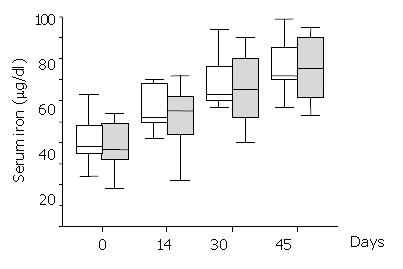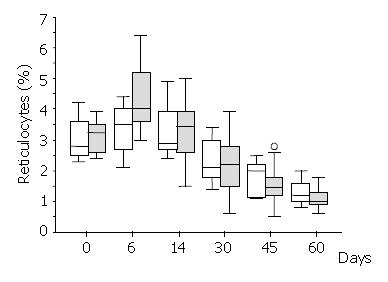Copyright
©The Author(s) 2004.
World J Gastroenterol. Feb 15, 2004; 10(4): 586-589
Published online Feb 15, 2004. doi: 10.3748/wjg.v10.i4.586
Published online Feb 15, 2004. doi: 10.3748/wjg.v10.i4.586
Figure 1 Box-and-whisker plots showing a progressive increase of serum iron levels over the recovery period from peptic ulcer bleeding of patients treated with either Epoetin alfa plus iron (G1, dashed whiskers) or iron only (G2, open whiskers).
There were not any statistically significant differences between treatment groups anytime during the study (two-tailed Mann-Whitney U test > 62, P > 0.67).
Figure 2 Box-and-whisker plots showing percent reticulocyte counts over the recovery period from peptic ulcer bleeding of patients treated with Epoetin alfa plus iron (G1, dashed whiskers) and those treated with iron only (G2, open whiskers).
On day six patients in G1 had significantly different (higher) median percent reticulocyte counts as compared with G2 (two-tailed Mann-Whitney U test = 46.5, P = 0.03).
Figure 3 Box-and-whisker plots showing haematocrit values over the recovery period from peptic ulcer bleeding of patients treated with Epoetin alfa plus iron (G1, dashed whiskers) and those treated with iron only (G2, open whiskers).
On day four-teen patients in G1 had significantly different (higher) haematocrit values as compared with G2 (two-tailed Mann-Whitney U test = 49.0, P = 0.041).
- Citation: Ladas SD, Polymeros D, Pagonis T, Triantafyllou K, Paspatis G, Hatziargiriou M, Raptis SA. Does recombinant human erythropoietin accelerate correction of post-ulcer-bleeding anaemia A pilot study. World J Gastroenterol 2004; 10(4): 586-589
- URL: https://www.wjgnet.com/1007-9327/full/v10/i4/586.htm
- DOI: https://dx.doi.org/10.3748/wjg.v10.i4.586











